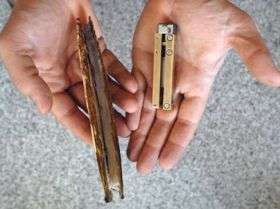RoboClam could lead to 'smart' anchors, more

(ĖĮÐÄĘÓÆĩOrg.com) -- The simple razor clam has inspired a new MIT robot that could lead to a âsmartâ anchor that burrows through the ocean floor to reposition itself and could even reverse, making it easier to recover.
The RoboClam is being developed to explore the performance capabilities of clam-inspired digging, as well as to shed light on the behavior of the real animal.
âOur original goal was to develop a lightweight anchor that you could set then easily unset, something thatâs not possible with conventional devices,â said Anette âPekoâ Hosoi, an associate professor in the Department of Mechanical Engineering whose collaborators on the work are Amos Winter, a graduate student in her lab, and engineers at Bluefin Robotics Corp.
Such devices could be useful, for example, as tethers for small robotic submarines that are routinely repositioned to monitor variables like currents and temperature. Further, a device that can burrow into the seabed and be directed to a specific location could also be useful as a detonator for buried underwater mines.
Winter presented the teamâs latest results Nov. 23 at a meeting of the American ĖĮÐÄĘÓÆĩical Society.
For several years Hosoiâs research has focused on novel propulsion mechanisms inspired by nature. So when faced with the anchor problem, âWe thought, âis there an animal thatâs well adapted to moving through sediments on the seafloor?ââ
The first stage of the research, said Winter, involved âlooking at all the organisms I could find that dig into the ocean bottom, stick to it or cling to it mechanically.â
He found what the researchers dub the Ferrari of underwater diggers: the razor clam. The animals, about seven inches long by an inch wide, âcan go about a centimeter a second, so you have to dig fast to catch them,â said Winter, who became a licensed clam digger as a result of the research.
Another reason why razors make a good model for novel anchors: they can dig deeply (up to about 70 centimeters). Plus, in a measure of anchoring force, or how hard you pull before an anchor rips out of the soil, compared to the energy required to embed the anchor, ârazor clams beat everything, including the best anchors, by at least a factor of 10,â Winter said.
Research subject in hand, one of the teamâs first tests gave perplexing results. They pushed a clam shell cast in epoxy into âsandâ composed of glass beads, and compared the amount of force necessary to do so to what the living animal is capable of. They found a major discrepancy between the two.
âTheyâre much too weak to do what they do,â Hosoi said. âSo we knew they were doing something tricky.â
To find out what, Winter created a glass-sided box filled with water and beads, added a living clam, and watched the animal burrow. It turns out to be a multi-step process. The animalâs tongue-like âfootâ wiggles down into the sand, then the animal makes a quick up-and-down movement accompanied by opening and closing its shell. Together these movements propel it.
By filming the movement of the beads, Winter made a startling discovery. The clamâs quick up-and-down, opening-and-closing movements turn the waterlogged âsandâ around it into a liquid-like quicksand. Experiments showed that âmoving through a fluidized substrate [the quicksand] rather than a packed granular medium [ordinary sand] drastically reduces the drag force on the clamâs body, bringing it to a point within the animalâs strength capabilities,â Winter will report Nov. 23.
Over the past summer, Winter completed the RoboClam itself. Although only about the size of a lighter, it is supported by a large apparatus of pressure regulators, pistons and more that control such things as how hard the robot is pushed in each direction.
âRight now weâre getting it up and runningâ for tests, Winter said. Among them, âwe want to use RoboClam to verify the theory weâve generated to describe how to dig like a clam.â
This work was sponsored by Bluefin, Battelle, and Chevron.





















